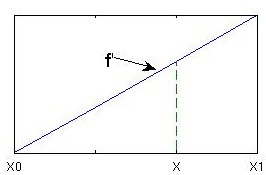 |
||||||||
 |
 |
 |
 |
|||||
 |
||||||||
 |
||||||||
 |
 |
|||||||
 |
||||||||
 |
||||||||
 |
||||||||
 |
||||||||
 |
||||||||
INTERPOLATION
Interpolation is the calculation of the value of a function between the values already known (Fig. 1↓). The most common type of interpolation is linear (1st order) interpolation. This can be viewed as comparing similar triangles using a 1 st order Taylor series definition of the slope:
f’
=
(f(x1) − f(xo))/(x1 − xo)
f’
=
(f(x) − f(xo))/(x − xo)
Setting the slopes equal:
(f(x1) − f(xo))/(x1 − xo) = (f(x) − f(xo))/(x − xo)
f(x) = f(xo) + ((x − xo))/((x1 − xo))[f(x1) − f(xo)]
This same process can be used with higher-order Taylor series to interpolate with comparably higher-order accuracies, but this can be complicated and not cost effective.
Higher-Order Interpolation
Instead for higher-order interpolation, different series approaches can be taken. A polynomial in power form (Eq. 1) can be written easily in its summation form (Eq. 2), as illustrated in Figs. 2↓ and 3↓ for polynomials about 0 and a value, c, respectively:
(1)
p(x)
=
ao + a1*x + a2*x2 + ... + anxn
=
n⎲⎳i = 0anxn
(2)
p(x)
=
bo + b1(x − c)1 + ... + bn(x − c)n
=
n⎲⎳i = 0bn(x − c)n
Next Page →
Next Page →


